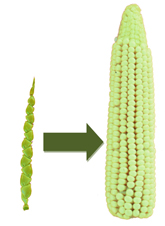|
By 125,000 years ago, large brained hominid species were living in Europe, Asia and Africa. In Europe and the Middle East lived the Neanderthals, a species very similar to humans but stronger and stockier. In East Asia lived the last remnants of Homo erectus that had evolved a brain size almost as large as Neanderthals and modern humans, and in Africa lived our own ancestors: the first modern humans (Homo sapiens). An Explosion in Artistic Expression There seems to have been something unique in the way Homo sapiens thought that contrasted with other hominids: wherever Homo sapiens went they created artwork. The earliest example of artwork comes from Blombos Cave in South Africa, dated to between 100,000-70,000 years ago. But by 40,000 years ago, as Homo sapiens expanded across Europe, Asia, and Australasia, we see an explosion of art in the form of human and animal figurines, decorative body ornaments, and cave paintings. One of the striking features of early human art is that we can see similar artistic styles on other sides of the world from each other. For example similar hand stencils, made by placing the palm of the hand on a cave wall and spraying paint around the hand, can be found at El Castillo Cave in Spain, at Maros Cave in Indonesia, and at Cueva de los Manos in Argentina. In Europe we cannot be 100% sure that all of this artwork was made by Homo sapiens because Neanderthals were occupying the same region. In fact body ornaments found at Grotte du Renne in France were most likely made by Neanderthals.(Ref.) Which means that Neanderthals were perhaps also simultaneously developing an appreciation for art, or were copying the culture of the newly arriving Homo sapiens, or through interbreeding with Homo sapiens, had recently acquired some of the human genes for artistic expression. The Human Settlement of the Americas During the last Ice Age, sea levels were much lower than today and the Americas were actually connected to Asia via a land bridge known as Beringia. Using this land bridge it was literally possible to walk between Siberia and Alaska. And evidence of an alleged human worked mammoth bone found at Bluefish Cave suggest that the first humans may have arrived in Alaska as early as 28,000 years ago. However during the coldest periods of the Ice Age the route from Alaska to the rest of America was blocked by a huge glacier known as the Laurentide Ice Sheet. (See map 6 – 20,000 years ago) Around 16,000 years ago the ice sheets began to shrink as temperatures rose, this eventually exposed two possible migration routes for the first human migrants to take into the rest of America: a coastal route and an inland route. (See map 7 – 15,000 years ago). What is striking about the settlement of the Americas is how far humans reached in just a couple thousand years. Settlements as far south as the southern end of Chile are dated to between 13,000-12,000 years ago. (See map 8 – 12,000 years ago) On the maps above you will see the site of Pedra Furada in Brazil. Most of the tools and cave paintings here can be dated to within the last 10,000 years. However some charcoal inside the rock shelters can be carbon dated to 48,000 years ago.(Guidon) If these charcoals were created by human-made fires, then it would push the human settlement of the Americas back by 30,000 years. Though some archaeologists have pointed out that the charcoals may have been made by natural fires.(Melzer) Starting around 11,000 years ago, Homo sapiens started to select, breed, and domesticate plants and animals. The development of agriculture occurred many times independently, first in the Fertile Crescent of the Middle East around 11,000 years ago with the cultivation of wild grains into wheat and barley. Then around 9,000 years ago, rice was cultivated in China, and bananas and sugar cane in the New Guinea Highlands. (See map 9 – 10,000 years ago). Over the next few thousand years, agriculture would continue to spring up in new places and spread into new regions. It was developed independently in the Americas with the cultivation of maize, and the cultivation of wheat and barley spread from the Near East into Europe. In the more arid areas of North Africa, Arabia, and Central Asia mobile pastoralists domesticated sheep and horses. (see map 10 – 7,000 years ago). Thus mankind had transformed itself from simply a predator to a producer. Agriculture did not just mean growing crops and raising animals, but also selecting the biggest, strongest and most nutritious specimens and breeding them over many centuries to produce more and more useful plants and animals. In fact the majority of the foods and animals that humans eat today are markedly different from their wild ancestors because they have been bred by humans to maximize their size and nutrition for so long. The agricultural revolution marked a major turning point in human history for a number of reasons: it allowed humans to settle down into permanent villages, it required cooperation among larger groups which led to more complex societies, and it produced an abundance of surplus food which led to dramatic population growth and allowed people to specialize in other occupations aside from food production, such as craftsmen, builders, soldiers, priests, etc. So villages transformed into towns and then into cities, and the first state societies and advanced civilizations developed. (See Map 11 – 4,000 years ago) |
 العربية
العربية




